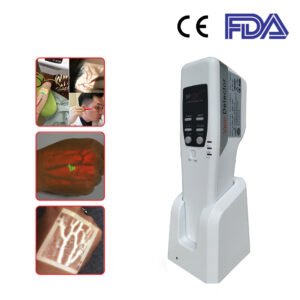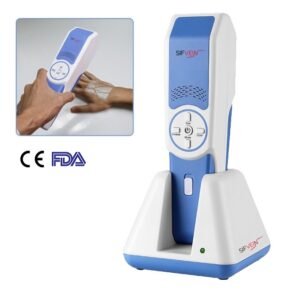The use of vein finders with Polycythemia
Polycythemia is a condition in which the number of red blood cells in the body increases. Blood becomes heavier as a result of the extra cells, which raises the chance of such health problems including blood clots.
Polycythemia is normally reported in terms of increased hematocrit (hematocrit is the ratio of the volume of red blood cells to the total volume of blood) or haemoglobin concentration (haemoglobin is a protein responsible for transporting oxygen in the blood).
It can be caused by a variety of factors, each of which has its own set of treatment choices. Polycythemia is treated by fixing any underlying symptoms and exploring solutions to lower blood cell counts, if possible.
There are two types of polycythemia:
* Primary polycythemia which also called polycythemia vera (PV): is a rare, slow-growing blood cancer that is a type of condition known as a myeloproliferative neoplasm. PV causes the bone marrow to create excess precursor blood cells that develop and function abnormally, leading to the production of too many red blood cells.
* Secondary polycythemia that can occur if the increase in red blood cells is not due to the myeloproliferative disease of PV. It is mainly caused by being at a very high altitude, obstructive sleep apnea, certain types of tumor, and heart or lung disease that causes a low oxygen level in the body.
In polycythemia vera or other primary polycythemia syndromes, the treatment options are more specific. Phlebotomy (drawing blood or blood-letting) is the most essential part of the treatment. To inhibit the excessive development of red blood cells, some drugs have been considered in combination with phlebotomy.
Since phlebotomy is a very important key for treating polycythemia, using a vein finder is highly recommended to Hematologists. For example, The Vein Finder SIFVEIN-5.2 can realize the original position projection and improve the vein recognition rate and this would make the work easy for medical professionals.
Vein finder SIFVEIN-5.2 has a different wavelength; to allow the absorption of light by oxyhemoglobin in surrounding tissues and vessels. After photoelectric conversion and image processing, the information is filtered to display veins on the screen. It is used to find veins at ease. Observe search for subcutaneous superficial blood vessels and for assisted puncture. Such as assisted venous diagnosis and intravenous injection.
The enhanced model has various colors, which can improve veins’ clarity and identification effectively.
During hospital care, the SIFVEIN-5.2 aids in the identification of the proper vein. Nurses may clearly keep the device over the skin to see the veins that are visible on the surface. Vein finders are simple to use and can greatly reduce patient anxiety while saving time for both nurses and patients.
References: Polycythemia Vera: Doctor Discussion Guide, High Red Blood Cell Count (Polycythemia) Symptoms, Types, Causes, Diagnosis, Treatment, and Life Expectancy, Polycythemia: Everything you need to know,



